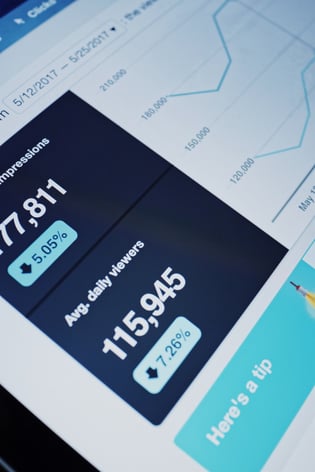More money spent on digital ads than on their traditional counterparts? It is not only just the future, but a very close future – meaning the rest of 2019. According to a research by Techcrunch, this year, digital advertising will make up 54.2% of total ad spend in the US and by 2023 it will account for over 2/3 of it. That is exactly why many companies are steadily increasing the budget allocated to digital, making it one of their most important marketing channels.
Making sure there is enough money to conduct a successful digital campaign is a crucial step – but only when the ads themselves are on point.
Digital ad components
Creatives, amongst many other components, are what often makes a certain ad effective, therefore accomplishing the desired result. The typical elements of a digital ad are assets, slogan, copy, logo and a call-to-action (CTA). Let’s have a look at each of them.
Assets are pictures chosen by advertisers to best showcase the given product or service. They differ from simple backgrounds which leave space for the actual messaging that marketers want to convey to detailed product photos in a chosen context. Text on a monochrome background makes an ad a so-called text-only ad.
Creating a catchy slogan is  a big challenge – it’s not easy to present a complex concept in a few words only – and make it engaging enough for people to continue on reading the body. It can be either a very clear message such as “5 ways to become a digital marketing guru” or something more intriguing – “Get a golden ticket today”. However, it should not interfere with the overall brand messaging strategy and the campaign goals. It is important to make sure that the body does not exceed any character limits, as well as whether the sum of all text elements of an ad complies with each platform’s rules. For example, Facebook’s text to image ratio requirement is 20% or less and neglecting this regulation will result in the ad being rejected or a worse performance.
a big challenge – it’s not easy to present a complex concept in a few words only – and make it engaging enough for people to continue on reading the body. It can be either a very clear message such as “5 ways to become a digital marketing guru” or something more intriguing – “Get a golden ticket today”. However, it should not interfere with the overall brand messaging strategy and the campaign goals. It is important to make sure that the body does not exceed any character limits, as well as whether the sum of all text elements of an ad complies with each platform’s rules. For example, Facebook’s text to image ratio requirement is 20% or less and neglecting this regulation will result in the ad being rejected or a worse performance.
A logo placed in a digital ad builds brand awareness and is usually the third most dominant element after the value proposition and CTA.
Call-to-action is a button inviting viewers to click on an ad and move to another webpage. It includes actions such as “Learn more”, “Buy now” or “Try for free” and many more – depending on the ad’s purpose and on where a customer is in the marketing funnel.

These elements are not placed on an ad creative randomly though. Neither should they be allocated according to personal preferences of a person creating the ad.
There is a science behind advertising and digital ads are no different here – their anatomy has been analyzed over and over to achieve the best results, while keeping in mind the important aspect of a brand identity being expressed through the ads. The consistency in fonts, colors and layouts helps viewers recognize the brand within the very short time in which they are exposed to an ad.
I have designed a fancy logo… but where to place it?
Logo is the main element serving for brand recognition. Its characteristic is the independency from other digital ad elements such as CTA, because a logo added to an image can already make a highly effective ad. However, there is a crucial condition for that – people need to know the brand already. Otherwise, a catchy slogan is a better candidate to do the job.
In brand recognition ads, logo is the king – it’s big and clearly dominating over all the other elements. When a CTA is added to an ad, logo should still be visible, but it shouldn’t draw more attention than the action that we want people to perform. The moment photos appear, logo stays in the corner and ensures brand consistency, but it is just an add-on and not a dominating element. Changes to logo’s color should be aligned with the brand’s individual visual guidelines and respect the color relationship with ad’s background.
Some factors deciding on where to place the logo within an ad are target audience characteristics, main message of an ad or product category. In general, logos tend to be placed on the left side of an ad, as it is said to bring better brand recognition. Central position of the logo is also a popular choice – if it fits better into the background. However, choosing a right-side position decreases the likelihood of an ad to be remembered.
How to choose a CTA?
 Choosing a proper call to action is the key to getting high conversion rate. Most importantly, it needs to be relevant to the stage of sales funnel that a customer is at. This will make the ad fit into the audience’s intents and increase the chances of getting attention. Four important components of every CTA are: design, text, value proposition and placement in the customer’s journey.
Choosing a proper call to action is the key to getting high conversion rate. Most importantly, it needs to be relevant to the stage of sales funnel that a customer is at. This will make the ad fit into the audience’s intents and increase the chances of getting attention. Four important components of every CTA are: design, text, value proposition and placement in the customer’s journey.
CTA should be easily noticeable, catching viewer’s focus with contrasting colors, appropriate size and font. Writing an effective copy for a CTA is an art of proper noun and verb usage – it’s not enough to say “Buy now!” and expect masses to make a purchase. People, above all, need to know what they are getting themselves into after clicking the button.
Sales funnels vary depending on many factors such as industry and potential customer profiles. Here are the examples of CTAs used at particular stages of the funnel:
- Awareness stage – educating the audience – “Download a free eBook”, “Read more on our blog”, “Learn more”
- Evaluation stage – positioning the product/service as a good solution for potential customers – “Download a free guide”, “Register for a webinar”, “Register for an info session”
- Purchase – making sure that people buy from you and not your competition – “Register for free today”, “Get your membership.”
Solving the misconceptions
The opinions of advertisers on digital ads vary. Some diligently argue that one of the elements is most important to a successful ad and others’ influence of the final purchase decision is not significant. The truth is that there is a science behind all that, and an effective digital ad sometimes doesn’t have a lot in common with what we consider “a pretty ad”. Embracing data-driven designs is a promising way to increase conversions and getting better results for your brand.

If you feel like a good revision of digital ad basics is what you need, please check our article "What lies in a good digital ad". We have introduced types of digital ads and basic principles across the network, presented tips on achieving higher digital marketing Return On Investment (ROI) and covered the topic of digital marketing budget.